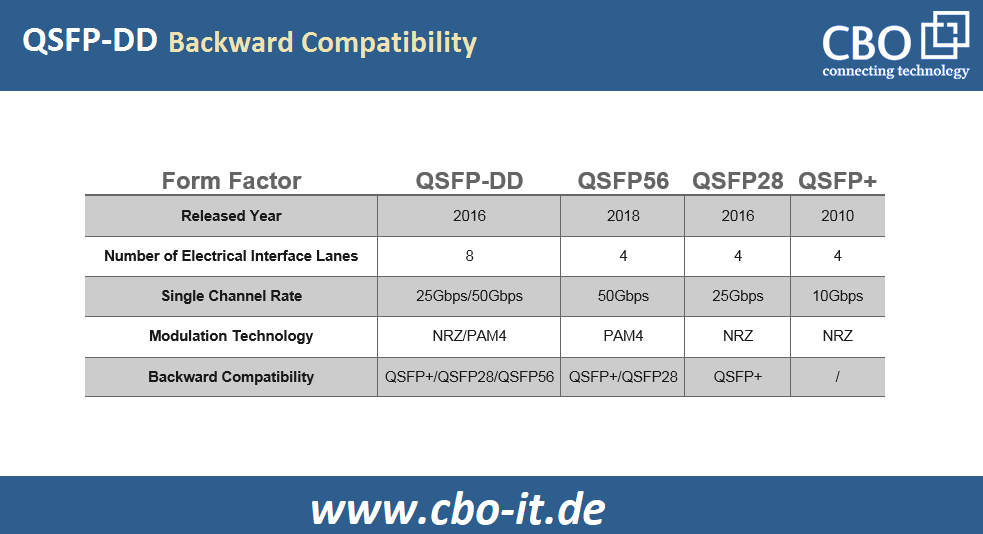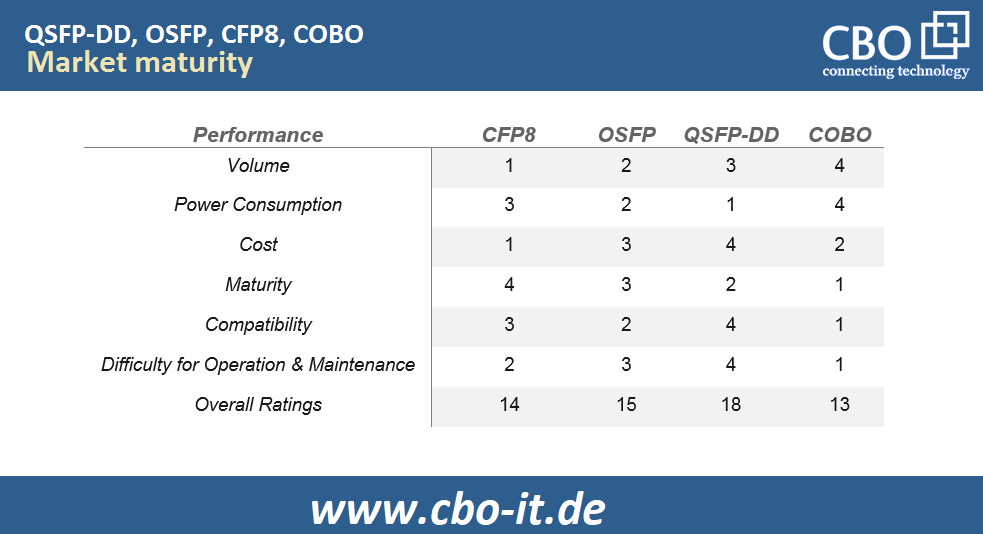Being the smallest of commercially available 400G form factors, QSFP-DD provides the greatest bandwidth density in the market while offering compatibility to various lower-speed QSFP pluggable transceivers and cables as well. QSFP-DD is frequently compared with other optical modules such as OSFP, COBO, CFP8, and QSFP56 when it comes to 400G applications. In this post, we will learn about the differences between QSFP-DD and other modules, their structure, advantages, and disadvantages.
QSFP-DD Introduction
QSFP-DD is designed to fully comply with QSFP-DD MSA and IEEE802.3bs standards. The “double density” in the context of this transceiver means the doubling of high-speed electrical interfaces supported by the QSFP-DD transceiver compared to any standard QSFP28 module. Each channel`s data rate can touch 25Gb/s through a modulation technology called NRZ – resulting in the realization of 200G transmission. However, up to 50Gb/s data rates per channel are achievable through PAM4 modulation technology for 400G network transmission.
Advantages of QSFP-DD
- It uses a 2 by 1 integrated cage/connector to accommodate both the two-high and one-high stack cage connector systems.
- SMT connector along with 1xN cage design: this type of design can handle at least 12W per module in terms of the thermal support. The greater thermal support lowers the necessity for heat dissipation capabilities of optical transceivers. Thus, this design feature can help in reducing some unnecessary costs.
- Backward compatibility: the QSFP-DD may support current QSFP modules (QSFP56, QSFP+, QSFP28, and others), giving end-users and system designers more options.
- ASIC design: various interface rates are supported and the modules are completely backward compatible with QSFP28 and QSFP+ modules, lowering port and equipment deployment expenses.
QSFP-DD vs QSFP56, QSFP28 and QSFP+
QSFP+, QSFP28, QSFP56, and QSFP-DD all are included in the family of QSFP form factors. In the following descriptions, we will study the differences between different QSFP form-factor transceivers.
Structure
The QSFP-DD has the same width, length, and depth as the QSFP+, QSFP28, and QSFP56 in terms of aesthetics. However, unlike other QSFP modules, the QSFP-DD module has an 8-lane electrical interface instead of a 4-lane and the ASIC ports of the QSFP-DD are doubled to accommodate prevailing interfaces such as CAUI-4. To cover the extra row of contacts, the mechanical connections of 200G & 400G QSFP-DD on the host panel are somewhat deeper than that of conventional QSFP transceivers.
Application & Bandwidth
The QSFP-DD modules can handle 400Gbps, while the QSFP+, QSFP28, and QSFP56 modules can only support 40Gbps, 100Gbps, and 200Gbps, respectively. As a result, QSFP-DD connectors are found in 400G optical modules, AOCs, and DACs, as well as 400G data center connectivity. For 40G, 100G, and 200G networks, QSFP28/ QSFP56/ QSFP+ modules, and AOC/DAC are employed.
Compatibility with Previous Versions
The QSFP-DD can stay backward compatible with earlier QSFP system transceiver modules. In simple words, the QSFP-DD has been technicality modernized to operate with increased bandwidth in contrast to the prior form factor. Because of its backward compatibility, we can avoid existing hardware replacement and ensure a swift network upgrade at an optimum cost.

QSFP-DD VS OSFP/CFP8/COBO
The form factors of 400G optics in markets include QSFP-DD or QSFP56-DD and COBO/ OSFP/ CFP8, with the following differences:
CFP8 vs QSFP-DD
The CFP8 module, which has a physical factor of 41.5mm x 107.5mm x 9.5mm, provides four times the bandwidth of conventional 100G systems. Its electrical interface has been designed to provide 16 x 25 Gb per second and 8 x 50 Gb per second data rates. CFP8's power consumption is much higher than QSFP-DD because its size is nearly three times that of QSFP-DD. The CFP8 is not compatible with QSFP+/QSFP28 ports. CFP8 and QSFP-DD both have a maximum bandwidth of 400 GB/s, however, CFP8 only supports 8x50G or 16x25G, whereas QSFP-DD supports both 200Gb/s and 400Gb/s (8x25G).
OSFP vs QSFP-DD
OSFP is a recent pluggable form factor with eight hi-speed electrical pathways that can handle 400Gb/s to 800Gb/s (8x50G). QSFP-DD is 18.35mm wide, 89.4mm long, and 8.5mm thick, whereas OSFP is 22.58mm wide, 107.8mm long, and 13.0mm thick. Although the OSFP form factor is somewhat deeper and wider than the QSFP-DD; still it supports 36 OSFP ports allowing for 14.4Tb/s per 1U.
In general, QSFP-DD consumes 7 to 12 watts of power, but the power consumption of the OSFP can reach up to 12 to 15 watts. The leaner the power expenditure the higher the performance of the optical transceiver. Because OSFP has larger dimensions, it cannot be fully compatible with QSFP+/QSFP28, unlike QSFP-DD.
COBO vs QSFP-DD
For on-board optics, COBO may be fitted in a controlled setting to a line-card kit that lacks flexibility. COBO modules are also more difficult to maintain than QSFP-DD since they do not support hot plugging. In addition, the COBO form factor comes with two electrical interfaces, one contains eight lanes and the other contains sixteen lanes, to support both types of transmission; 1x400G and 2x400G.
The following chart exhibits the market maturity of various form factors. In this chart, higher numbers reflect higher market maturity of different form factors.

In the light of the above exhibit, it can be concluded that the overall rating of OSFP and QSFP-DD form factors are greater than other form factors. The fiber optic producers prefer the OSFP and QSFP-DD. While the latter is often preferred in telecommunication applications the former is considered more suitable for data center environments.
The Future of QSFP-DD in 800G Ethernet Market
In comparison to OSFP or the QSFP-DD is better suited for the data center environment. The time break between the use of high-speed optical modules in the telecommunication industry and the data center marketplace is progressively closing due to the increasing concentration of east-west traffic in the data center and the rising strain on the data center's internal bandwidth. It is supposed that the 400G optics will be widely used. That is, the 400G Ethernet will benefit QSFP-DD, paving the way for a positive outlook.
Single-wave 100G technology is expected to mature when 400G becomes commercially accessible on a wide scale, providing the basis for the advent of 800G. The QSFP-DD800 Multi- MSA organization has recently issued the first edition of the QSFP-DD800 transceiver hardware standard, which is devoted to extending the available version of the QSFP-DD form factor to enable a single channel rate 100Gbps for the new formation QSFP-DD800 with eight channels. It also implies that 800G may still capitalize the characteristics of the QSFP-DD form factor to make it more beneficial for internet service providers.
 English
English
 Deutsch
Deutsch
 Espaniol
Espaniol










